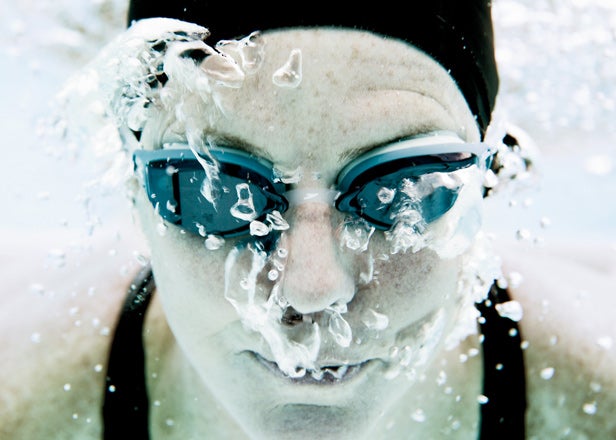“I HAVEN'T HAD┬ámany challenges in my life,” Jennifer Figge tells me between bites of shrimp tagliatelle and sips of chardonnay at Aspen's L'Hostaria restaurant. The 58-year-old local is explaining the motivation behind her endurance runs across India and Mexico and her marathon swims from France to Italy, Turkey to Greece, and across the AtlanticÔÇötwice. “This is a way I can challenge myself.”
Jennifer Figge
 “I was never a runner, and I'm not a swimmer,” Figge says. “Being in the ocean just gives me life.”
“I was never a runner, and I'm not a swimmer,” Figge says. “Being in the ocean just gives me life.”And then she's interrupted by passing friends again. After pleasantries and a few inquiries about her motherÔÇöAmerican opera star Margherita RobertiÔÇöthe conversation turns, as it inevitably does with Figge, to what's next. “A dip,” she says coyly. “A dip in the Pacific!”
Some dip. Starting in December, Figge will attempt an unprecedented swim through long stretches of the 3,000-mile expanse between Cabo San Lucas, Mexico, and Hawaii. In the process, she'll probably reignite the controversyÔÇöwhat exactly counts as a swim “across” an ocean?ÔÇöthat she sparked in 2009 when she performed a similar series of swims in the 2,500-mile stretch between the Cape Verde Islands, off Africa, and Trinidad.
That's because Figge's method involves drifting much of the way on a catamaran. Like Frenchman Benoit Lecomte before her, who used the same approach during his 1998 swim from Massachusetts to France, Figge alternated swimming during the day with sleeping aboard a boat that floated with the currents at night.
To date, only Figge and Lecomte have crossed the Atlantic, and nobody has come close to actually swimming every foot of a vast ocean. That part got lost in translation after Figge's first Atlantic swim, a situation that she and her PR handlers may have exacerbated by not explaining it clearly from the beginning. When Figge reached Trinidad after 25 days, she spoke with a local reporter. The AP soon reported that she'd “swum across the Atlantic.” Media outlets in the U.S. picked up the story of the heroic athlete, with the CBS Evening News calling her feat an “extraordinary accomplishment.”
Then reporters did the math, realizing that swimming the whole way would have meant an impossible 100 miles per day. The accolades quickly turned to accusations. Corrections were issued, and some assumed Figge was lying.
A few reports wrongly claimed that she'd swum inside a towed shark cage, which creates drag and pulls a swimmer along. The Web was abuzz with talk of the “great Atlantic Ocean swimming hoax.”
All of which misses a crucial point. Limited though the swim had been, Figge's feat was, in fact, remarkable. She'd made her way 250 miles across the Atlantic, logging up to 28 miles and 12 hours per day through 20-foot swells. There was the constant worry that if her tiny bobbing figure drifted more than a few hundred yards from the boat, she might be lost forever. Despite the dangers, she quietly repeated her feat last May, this time swimming 300 miles, sustaining 22 jellyfish stings, and being investigated by cruising sharks on three occasions. Though Figge still refers to “my Atlantic swims” in conversation, she also says she isn't claiming anything. “I'm not in it for the records,” she says. “I'm in it for the romance.”
But to many marathon swimmers, swims like Figge's and Lecomte's are an affront to accuracy. Lynne Cox, the legendary cold-water marathon swimmer, says that in her opinion a legitimate swim means “you start on land and you finish on land, and you don't have any assistance in between.” In order for a stage swim to count for much, she'd have to restart in the morning from the same place she left off the night before. That would likely require several ships to relay fuel to the main chase vessel. The route Figge took would require more than 200 days of constant motoring against the current and potentially cost millions. Figge has money to work withÔÇöher expeditions are underwritten by her husband, Tom, a wealthy retired bankerÔÇöbut not that much.
Wherever she belongs in the record books, Figge remains a fascinating specimenÔÇöa rich socialite who gets her kicks through incredibly tough physical feats. She grew up in Davenport, Iowa, and married Tom in 1974, when she was 21. They have one son, Alex. For his seventh birthday, Alex asked Figge to give up smoking. Though she was never a serious athlete growing up, she ran the Chicago Marathon in 1985 and then took up ultrarunning as a substitute habit. After Tom began riding The Des Moines Register's Annual Great Bicycle Ride Across Iowa (RAGBRAI), she decided to run across the state. In 1989, she completed 300 miles in 12 days. She crossed Illinois the following year, then took her endurance feats abroad.
Over the next four years, Figge ran across eight countries, including a 350-mile traverse of Romania, 300 miles across Iceland, and 180 miles from ocean to ocean in Mexico, where she suffered a stress fracture and had to hobble the final 60 miles in a cast.
Figge turned to swimming after that injury. Since then, she's undertaken 25 open-water crossings, including classics, like the 12-mile Strait of Gibraltar, and obscure ones, like the 5.6-mile Strait of Tiran, in the Red Sea. She initially came up with her swimming plans while looking at a world atlas, gauging distance with a piece of string, which, she says, was “close enough.”
Like her fifty-something friends in the Aspen scene, she stays in shape by hiking in the Rockies and meeting with a personal trainer at the posh Maroon Creek Club a few times a week. “I was never a runner, and I'm not a swimmer,” Figge says. “Being in the ocean just gives me life.”
Her life in the Pacific will include her standard crew of Tam ás H ámor, a Hungarian boat captain, and four others, including a Spanish doctor. Figge hopes to swim as much of the 3,000 miles as possible, maybe 400, by the time they reach Hawaii sometime in January.
“The worst nightmare of a captain is of somebody falling overboard,” says H ├ímor, “but with Jennifer, that's what we do every day: we just throw her overboard.”
Figge will be wearing a GPSÔÇłtracker, an electronic shark-repellent anklet, goggles, and a wetsuit to provide extra warmth and buoyancy. To keep from drifting away, the boat actually has to drive in reverse when Figge is in the water.
When the outsider finally reaches Hawaii, her critics will be doing everything they can to ignore her. And she'll no doubt return the favor. “A friend told me the other day, 'Well, you know, Jennifer, Hawaii isn't the whole Pacific,'” she says. “'I know,' I said, 'but it's a great spot to stop off for a mai tai.'”


